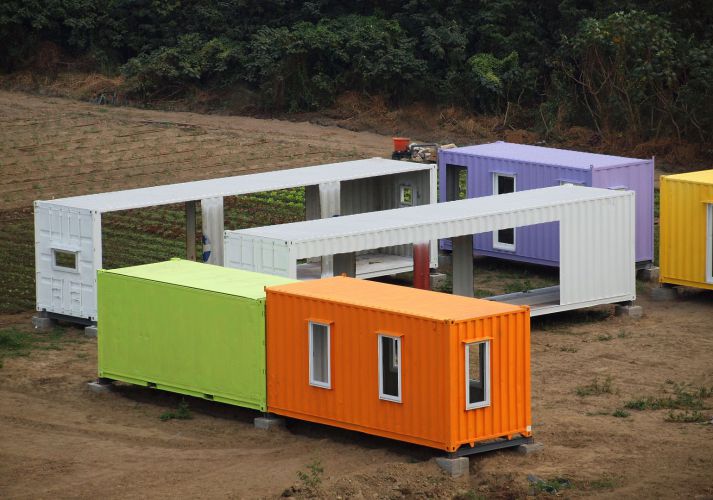- Rent, Lease, or Purchase
- |
April 7, 2021
Preparing Your Shipping Container Foundation

It can be important to provide a shipping container foundation before your unit arrives. While many entrepreneurs look to these structures for mobile solutions, it's becoming increasingly common to find them used for more permanent purposes.
Today, modular units can be converted into homes, schools, offices, restaurants, hotel rooms, and more. In order to maintain these buildings, a sturdy foundation must be created as support.
How Do I Know If I Need A Foundation For My Shipping Container?
The decision to create a foundation for your shipping container largely depends on where you plan to store your shipping container and how long you're going to use it. Typically, single-unit shipping containers used for mobile purposes will do just fine placed directly on a flat, dry surface.
However, if you plan on placing your container on bare earth or in an area that collects a lot of water, you'll need a foundation to prevent it from sinking into the ground. A sturdy foundation can keep heavy, multi-unit containers level and functioning well.
Different Types of Foundation
There are three main types of foundations you can use to secure your shipping container. They include the concrete pier foundation, concrete slab or raft foundation, pile foundation, and strip foundation.
1. Pier Foundations

This is probably the most popular foundation type, thanks to the ease in which it can be established as well as the affordable price tag. This type of shallow foundation is often recommended for a shipping container home. It consists of concrete cubes that contain reinforced steel bars for additional strength. These bars can also come in the form of a mesh or steel wires.
Pier foundations are considered the most DIY-friendly out of the list. Six concrete piers are typically required to create a pier foundation for a single shipping container. Two are placed in the center of the container to add support to the middle section while the remaining four are placed around the container corners.
These piers prevent the container structure from touching the ground. This helps establish proper ventilation and prevents condensation from forming underneath.
2. Slab Foundations

A concrete slab foundation is most suitable for soft soils and warm climates. While this type of foundation can be time-consuming and expensive to create, it is one of the strongest out there. It can be created by pouring concrete to form an even slab that will not fall apart when the container is placed on top of it. This type of foundation usually requires excavation of the entire area under the container.
One of the perks associated with a concrete slab foundation is that it contains no hollow space. This makes it especially resistant to terminate an infestation. This foundation type is most commonly used for shipping container homes and schools.
Drawbacks include the fact that utility lines can become difficult to access after the concrete hardens. Heat loss can also occur if ground temperatures fall below the interior temperature.
3. Pile Foundations
Pile foundations are used when the soil is too soft to support a concrete slab. They are the most expensive types out there.
This type of foundation can be created by hammering cylindrical solid steel tubes (or "piles") through the soft soil until a hard enough surface is reached to support the weight of the container. Once all the piles are secured in place, they'll be capped with a concrete block and eventually take the form of a grid system. Above ground, it will look pretty similar to a collection of concrete piers.
Because this foundation requires a good amount of digging, DIY installations are not recommended. It is better to contact a contractor who can lay the pile foundations with special building equipment.
4. Strip Foundations

Strip foundations are a combination of pile and concrete slab foundations. Also known as a trench foundation, they are made of a strip of concrete laid down to support your shipping containers. This strip can either be positioned around the perimeter of the counters or at the top and bottom of the containers instead.
This is typically considered a cheaper alternative to a slab foundation when working with softer earth. If you happen to be working in an area that receives a lot of rain, you can use a rubble strip foundation using loose stone below the concrete strip. This prevents the water from pooling together at the bottom of your container.
Drawbacks concerning this type of foundation include low resistance to earthquakes. They also contain a shallow form, meaning they should be reserved for small and medium-sized builds.
Conclusion
While not always necessary, creating a foundation for your shipping container can help protect your container structure and its contents. If you're interested in new or used shipping containers for sale, get in touch with our representatives. You can also take a look at our blog for more information about shipping containers and their many uses.
Frequently Asked Questions
How do you secure a shipping container to a foundation?
You can use ground plates with twist-locks to quickly and easily secure shipping containers to a foundation. Bolt the ground plates into the concrete and lower the container so that the corner castings line up with the twist locks. Pull the levers and secure. You can also attach your container to a foundation through a steel plate. This option involves pressing a steel plate with welded anchors underneath into the wet concrete.
What is the floor of a shipping container made of?
Most shipping container floors are made of marine plywood or timber planks.
What is the base of a shipping container?
Concrete is the most popular material to use for your base, though wooden beam footings are also available if you are looking for an easier and more affordable option.
How do you keep moisture out of a shipping container?
You can keep moisture out of a shipping container by using desiccant bags to absorb humidity, elevating your container with wooden pallets, or installing dehumidifiers and air conditioning units. You can also look into insulation and ventilation options to reduce the amount of moisture in your shipping container.
Related Blogs



Subscribe to Our Blog
Enter your email address to subscribe to the blog and receive the notification of new posts by email.
Thank You for Subscribing to Our Blog!
Stay tuned for upcoming emails with valuable content that we hope will enhance your experience with our brand.
Both Pardot and mg360 form submissions failed.
